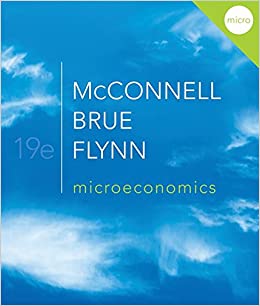
Microeconomics 19th Edition by Campbell McConnell,Stanley Brue,Sean Flynn
Edition 19ISBN: 978-0070998544
Microeconomics 19th Edition by Campbell McConnell,Stanley Brue,Sean Flynn
Edition 19ISBN: 978-0070998544 Exercise 1
Suppose that corn currently costs $4 per bushel and that wheat currently costs $3 per bushel. Also assume that the price elasticity of corn is.10, while the price elasticity of wheat is.15. For the following questions about elasticities, simply use the percentage changes that are provided rather than attempting to calculate those percentage changes yourself using the midpoint formula given in Chapter 4a. If the price of corn fell by 25 percent to $3 per bushel, by what percentage would the quantity demanded of corn increase? What if the price of corn fell by 50 percent to $2 per bushel?
b. To what value would the price of wheat have to fall to induce consumers to increase their purchases of wheat by 5 percent?
c. If the government imposes a $.40 per bushel tax on corn so that the price of corn rises by 10 percent to $4.40 per bushel, by what percentage would the quantity demanded of corn decrease? If the initial quantity demanded is 10 billion bushels per year, by how many bushels would the quantity demanded decrease in response to this tax?
b. To what value would the price of wheat have to fall to induce consumers to increase their purchases of wheat by 5 percent?
c. If the government imposes a $.40 per bushel tax on corn so that the price of corn rises by 10 percent to $4.40 per bushel, by what percentage would the quantity demanded of corn decrease? If the initial quantity demanded is 10 billion bushels per year, by how many bushels would the quantity demanded decrease in response to this tax?
Explanation
(a) 2.5 percentage points, 5 percentage ...
Microeconomics 19th Edition by Campbell McConnell,Stanley Brue,Sean Flynn
Why don’t you like this exercise?
Other Minimum 8 character and maximum 255 character
Character 255


